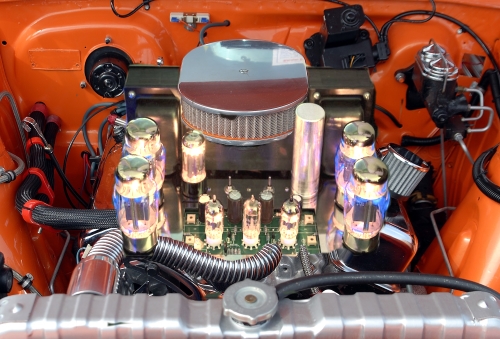
— What controls and features are required on the amplifier? [Is it crucial to be able to adjust amplifier gain? Should it be on the front panel or the back panel to meet your system needs? Do the gain attenuators need to be step-adjustable for consistent settings? Do you need to see clip indication, or thermal status?]
— What environment will the amplifier operate in? [Are loud, single-stage fans acceptable in a quiet performing area, or must you have thermo-sensing and multi-stage fan operation? How capable must the air filters be…is dust, lint or other foreign airborne matter going to a hazard?]
— What type of input and output configuration is required? [Connectors vary in different types of situations. Do you need XLR’s on the inputs and binding posts on the outputs? RCA or 1/4” phone jacks? All of the above? Should the A and B channels be strappable for bridged-mono operation?]
— What input sensitivity best suits your system needs? [An amplifier will develop its full, rated power output in response to a specified voltage level input. This varies from amplifier to amplifier, and is often adjustable internally. In a multi-amp system, calibration of input sensitivities is important for optimum system performance.]
— What is the intended duty cycle of the amplifier? [Will it be run 24 hrs. per day in a permanent installation? Will it receive a few hours’ hard use on a daily basis in a tour situation? Is it being purchased for long-term use in a certain application in a specific system, or will it be a building-block module as part of a rental company inventory, having to perform different functions at different times?]
— How important is serviceability? [Should it have modular plugin circuit cards for quick road replacement? Will it rarely pass through the shop to sit on a test or repair bench? Where are the fuse caps located? Are the output transistors readily accessible?]
— How will the amplifier be racked? [An amp that sits in an air-conditioned recording studio, built into a wall, will suffer far less abuse than an amp that travels around the country in the back of a truck. Mechanical design and chassis construction is a very real consideration for portable system use.]
— Will the unit be used for years until it gives out, or will it be sold or traded off as part of a regular system upgrading or expansion plan in the future? [Just like automobiles, some brands and models of power amplifiers have better resale value over time than others. If future resale is a consideration, this may influence your choice in suppliers].
The amplifiers that are available from today’s professional manufacturers have grown to be increasingly versatile, sophisticated and specialized. Where once “any old amp will do” may have been the saying, today’s sound professional carefully chooses products to suit the application, the load and the use environment.
Just as a newspaper ad that says only, “computer for sale” doesn’t give a potential purchaser very much to go on in terms of deciding if will suit his or her needs (Is it a DOS or Macintosh platform? Hard disc drive, SCSI port, internal modem?), so must we know many things about a power amplifier to determine its potential suitability in a system application.
An amp is not an amp is not an amp…
There is a tremendous variety of designs and models available from many different suppliers. Taking the time to closely examine a power amplifier’s performance, features and construction can mean the difference between choosing the ideal unit that won’t require much care and feeding, or in choosing a problem device that never quite delivers what was promised or is expected of it.
If you are involved in purchasing, specifying or using professional power amplifiers, it makes sense to be very clear on what you expect of this important part of your sound system. A good power amplifier may be practically invisible, and it may just be a piece of “wire with gain” that “has not sound of its own,” but whether or not it is truly good for your needs will be based on the amount of time that you take to determine how well it meets your specific requirements.
Editor’s Note: This is a series of articles from Recording Engineer/Producer (RE/P) magazine, which began publishing in 1970 under the direction of Publisher/Editor Martin Gallay. After a great run, RE/P ceased publishing in the early 1990s, yet its content is still much revered in the professional audio community. RE/P also published the first issues of Live Sound International magazine as a quarterly supplement, beginning in the late 1980s, and LSI grew to become the monthly publication that continues to thrive to this day.
